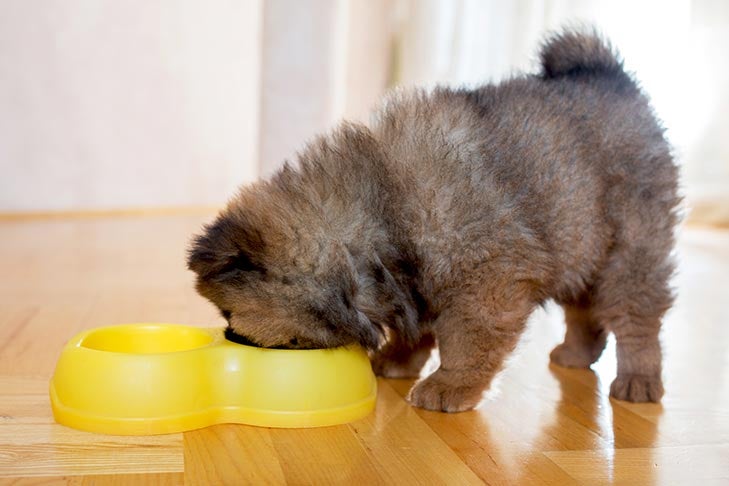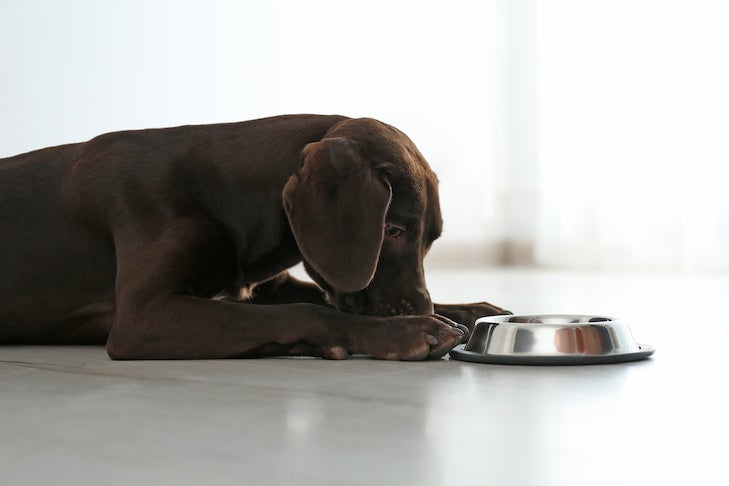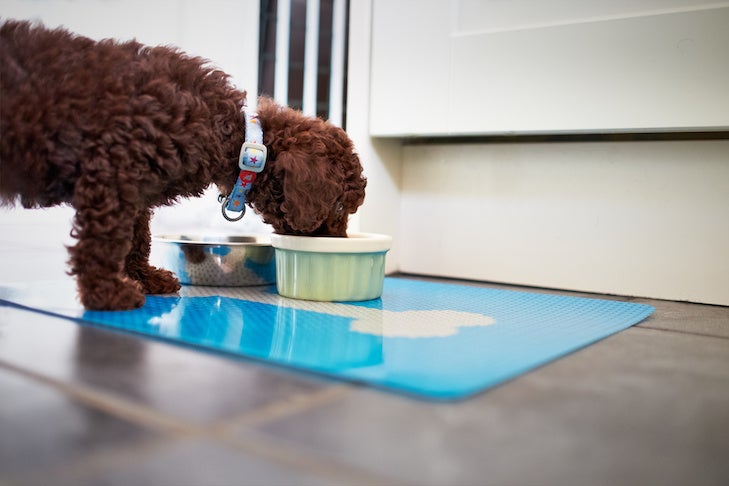
While a toy puppy may increase its birth weight by a factor of 10 to 20, a giant-breed puppy may grow to be 100 times bigger than when he was born. Consider this: A newborn Chihuahua may weigh only three ounces at birth and three pounds at maturity. A newborn Great Dane, however, may weigh only one pound at birth and 100 pounds at maturity. To get each to its adult weight in the healthiest manner, you’ll need to not only feed them different amounts of food, but also different types of food.
Large Breed Puppies
For years, breeders thought the best way to produce a big dog was to heap his bowl full of protein, calcium, and calories. But when a large-breed puppy grows too quickly, we learned, he can develop problems in the bones and joints. Consider the following:
- Protein is important for building muscle, which in turn helps develop sound joints. Large-breed puppies should eat a puppy food with about 26 percent protein.
- Calcium is needed for strong bones, but too much can cause just as much harm as too little. When too much calcium is absorbed, the body deposits it on bone tissue whether the bone needs it or not, causing bone reshaping and skeletal abnormalities.
- Calories are vital for growth, but puppies who consume too many calories and grow too heavy have a higher risk of osteochondrosis, hip dysplasia, and other joint problems. Very young puppies can eat a calorie-rich food since they need at least twice the calories per pound that adult dogs do, but as they age, they require fewer calories per pound. A diet with about 15 percent fat provides enough calories for growth but few enough to prevent the rapid growth that can encourage skeletal disease.
What’s a large-breed owner to do? First, remember: Ultimate size at maturity is genetically programmed; puppies that grow slower will still reach their adult size, just a little later. Don’t be in a rush to grow them big. Also, don’t make the mistake of feeding smaller amounts of regular puppy food to cut calories because that wouldn’t contain enough calcium. The best bet is to feed a commercial food specially formulated for large-breed puppies. Don’t add supplements (unless instructed by a veterinarian) and don’t overfeed.

Toy & Small Breed Puppies
Owners of toy-breed puppies don’t have to worry about them growing too big too fast, but they do need to make sure the puppies are eating regular meals to stave off hypoglycemia, a potentially fatal condition.
What causes hypoglycemia?
Very young small dogs have difficulty storing adequate amounts of glucose as glycogen. If they don’t eat often enough, or if they use a lot of energy from playing or being stressed, their body depletes its glycogen stores. When that happens, the body starts breaking down body fat for energy. But because small puppies have so little body fat, that energy source soon runs out. The body runs out of sufficient energy, and the brain, which is highly dependent on glucose, is one of the first systems to fail.
What’s the danger?
The puppy becomes abnormally sleepy, weak, and uncoordinated to the point that he may not even eat when offered food. If he doesn’t eat, the condition can progress to seizures, loss of consciousness, and even death.
How can feeding schedules prevent it?
Toy puppies are especially at risk between 6 and 12 weeks of age, but the threat remains for up to 7 months, and a few are susceptible even as adults. To avoid hypoglycemia, feed toy puppies frequently. A toy puppy younger than 4 months old should be fed four to five times a day and allowed to eat as much as he wants. From about 4 to 7 months of age, he can eat four times a day; from 7 to 9 months of age, three times a day; and by the time he’s 12 months of age, twice a day. When the dog can’t be fed as often as suggested, he should be kept warm and quiet so he doesn’t expend a lot of energy.
What foods should be avoided?
Avoid foods with simple sugars, such as sweets and semi-moist foods. Simple sugars tend to cause a rollercoaster effect with blood sugar levels, initially raising them but then causing them to plummet to a state of hypoglycemia. Feed meals fairly high in protein, fat, and complex carbohydrates. Also, toy puppies have little teeth, so they do better if fed a small-kibble food. Your best bet is to buy a commercial food specially formulated to meet the needs of small-breed puppies.

Medium Breed Puppies
And then there are the in-betweens— the medium-sized dogs—and if you have one, you’re in luck because most commercial dog foods and homemade diet formulations were developed with medium dogs in mind. If he is closer to the large size, watch his calories and weight; if he is nearest to the small size, make sure he eats frequently
No matter what size your puppy is, avoid fad diets, steel yourself against pleading eyes for your pizza roll, and don’t obsess over being perfect. While some diets are better than others, somehow dogs have been surviving for thousands of years without individualized nutrient profiles. Vary his diet, make sure you’re feeding high-quality food appropriate for his age and size, and relax and enjoy his puppyhood. It will be over way too soon

